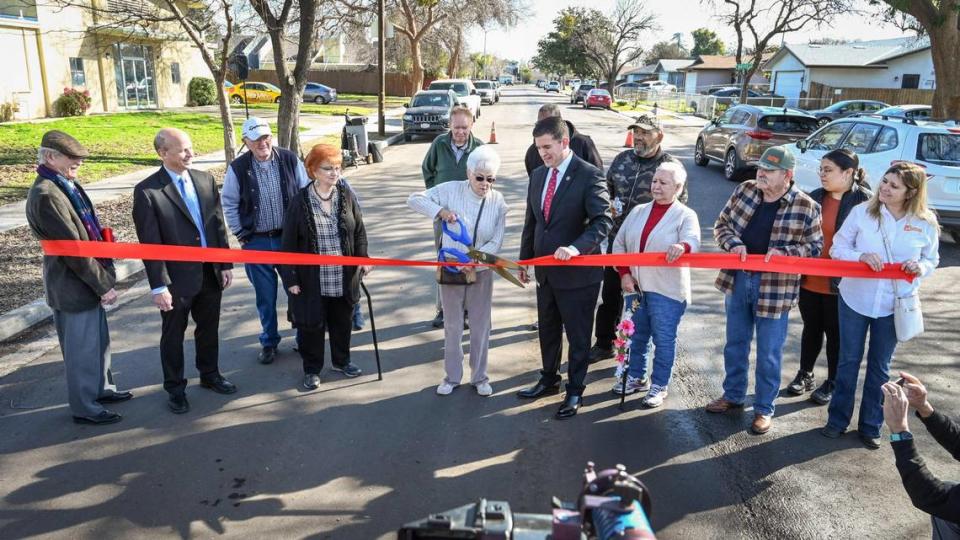‘He came through.’ Fresno residents thankful their streets finally repaved after 57 years | Opinion
Residents of an east-central Fresno neighborhood had good reason to be skeptical of a pledge Councilmember Tyler Maxwell made three years ago while on the campaign trail.
For decades, they hounded previous District 4 City Council members over the crumbling, pothole-filled streets around their homes that hadn’t been repaved since they were originally laid in 1966. That’s 57 years ago! In some spots, the asphalt had worn down to its gravel base.
Those efforts proved futile. Residents were either ignored by their elected representatives, given lip service or told the city didn’t have the money.
Their skepticism began to soften last fall when a paving company contracted by the city began a complete reconstruction of their neighborhood streets — a $1.8 million project funded by federal Community Development Block Grants.
Today, minus a few finishing touches, the transformation is complete. Streets so broken and bumpy that residents avoided driving them by cutting through a church parking lot are now buttery smooth. Sidewalks and curbs were also improved, including the installation of ADA-compliant truncated domes (i.e. yellow bumps) at certain intersections.
Opinion
“My attitude this whole time has been I’ll believe it when I see it,” said Bob Krum, who has lived in the same house since 1968 on the 4800 block of East Cambridge Avenue. “But now I see it, and I believe it.”
“He promised us, and he came through,” added wife Donna Krum, who gave Maxwell a big hug prior to a Tuesday ribbon-cutting ceremony commemorating the long overdue improvements.
Maxwell, who currently serves as council president, first learned about the deteriorated streets while canvassing the neighborhood prior to his March 2020 election victory.
Listening to those complaints prompted Maxwell’s promise to fully reconstruct residential streets bordered by North Chestnut, East Clinton, North Winery and East Normal avenues during his first term in office. To help keep it, he volunteered for the council’s CDBG committee.
“I was really bold when I told people I was going to take care of this in my first term,” Maxwell told me after the ceremony. “That put a lot of pressure on me, but that really guided me and my staff to stay focused.”

Huge need, small pot of money
Fresno spends about $12 million per year on pavement management, according to Public Works Director Scott Mozier. Which isn’t all that much considering there are 1,767 miles of roads within city limits.
“I wish I could’ve done it sooner,” Maxwell said. “With COVID-19 and materials and labor being backlogged, it took a little longer than we would’ve liked. But seeing some of the neighbors in tears today and hearing their stories … it’s a really good feeling.”
Maxwell has already identified other areas in his district that need street reconstruction and hopes to use his muscle as council president to make that happen.
No promises this time, however, as there are many neighborhoods in other parts of Fresno whose streets, curbs and sidewalks are also desperate for attention.
Municipalities measure the overall state of their roadways utilizing a Pavement Conditions Index score that ranges from zero to 100. Fresno’s average PCI is 60, according to Mozier, which is on the lower end of “fair.”
Just to raise the citywide average to 70, the minimum score for “good,” Mozier said Fresno would have to spend an additional $50 million per year on pavement management for the next decade.


Fresno’s insufficient pavement budget
How insufficient is the city’s current $12 million budget for paving and maintaining roads? Let’s put it this way: If Fresno continues to spend at that level, by 2031 the city’s overall PCI will drop to 43 and 57% of its streets will be in “poor” or “failed” condition.
Weather is also a factor. In recent weeks, Public Works crews have spent an inordinate amount of time (and money) filling potholes created by early January storms. Last month alone, there were 1,648 calls for potholes citywide. During 2022, the monthly average was 221.
I found those factoids — and a trove of interesting information about the state of Fresno’s roads — in a 27-page staff report prepared for a “pavement management presentation” scheduled for Thursday’s City Council meeting.
For example, did you know that the street network south of Shaw Avenue (60) has a slightly higher PCI score than the one north of Shaw (59)?
That certainly runs contrary to the usual narrative.
While residents of the Krums’ east-central neighborhood are thankful and appreciative, smoother pavement creates a new set of headaches: excessive speeding.
Maxwell indicated there is still a little money left over from the $1.8 million CBDG grant. The Krums hope it can be used to install a few rumble strips.
“I’m very happy, but we need something to slow traffic down through here,” Bob Krum said.

 Yahoo Movies
Yahoo Movies 
